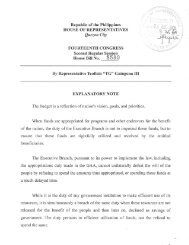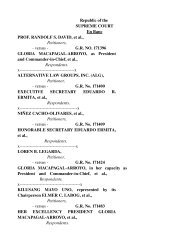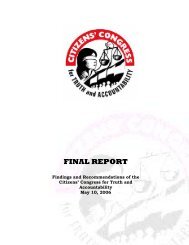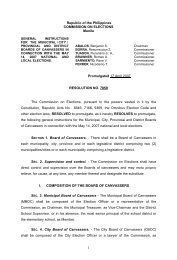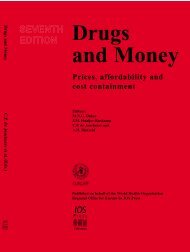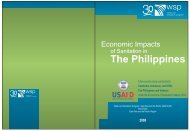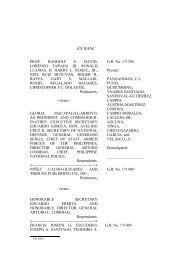Decentralization and Corruption in the Philippines
Decentralization and Corruption in the Philippines
Decentralization and Corruption in the Philippines
Create successful ePaper yourself
Turn your PDF publications into a flip-book with our unique Google optimized e-Paper software.
Our meritocracy variable was based on a number of subjective questions asked of<br />
<strong>the</strong> municipal health officer <strong>and</strong> <strong>the</strong> municipal adm<strong>in</strong>istrator. As with corruption, <strong>the</strong>re<br />
are presumptive reasons to suspect answers to subjective questions about meritocracy <strong>in</strong><br />
hir<strong>in</strong>g <strong>and</strong> promotions from senior officers who, after all, make <strong>the</strong>se decisions. Indeed<br />
<strong>the</strong> base values on some responses seem improbably high –96-97 percent of promotion<br />
decisions are allegedly made on <strong>the</strong> basis of merit <strong>and</strong> quality of service. We also had no<br />
real way of check<strong>in</strong>g <strong>the</strong> au<strong>the</strong>nticity of <strong>the</strong> responses o<strong>the</strong>r than to note <strong>the</strong> positive but<br />
<strong>in</strong>significant correlation (0.12 p-value=0.30) between <strong>the</strong> adm<strong>in</strong>istrator <strong>and</strong> <strong>the</strong> health<br />
officer responses. For this reason, <strong>and</strong> because of an overlap with corruption, we tend to<br />
avoid us<strong>in</strong>g meritocracy <strong>in</strong> <strong>the</strong> follow<strong>in</strong>g analysis but do use it as a robustness check for<br />
several regressions. Future replications of this study should survey at least two officers –<br />
one senior <strong>and</strong> one junior- <strong>in</strong> each office to generate more reliable data on sensitive<br />
management questions like meritocracy <strong>in</strong> hir<strong>in</strong>g <strong>and</strong> promotions. This would also permit<br />
important tests to be carried out on <strong>the</strong> reliability of <strong>the</strong> data.<br />
The next variable we exam<strong>in</strong>e is adjustability. Questions about adjustability are<br />
central to <strong>the</strong> study of local governments <strong>and</strong> to both positive descriptions <strong>and</strong> normative<br />
prescriptions about <strong>the</strong> extent of decentralization. The adjustability <strong>in</strong>dex is based on<br />
answers to questions about hir<strong>in</strong>g, fir<strong>in</strong>g <strong>and</strong> resource allocation. The <strong>in</strong>dices are aga<strong>in</strong><br />
between 0 <strong>and</strong> 100. The mean values of 62 <strong>and</strong> 63 for <strong>the</strong> municipal health officer <strong>and</strong><br />
<strong>the</strong> municipal adm<strong>in</strong>istrator <strong>in</strong>dicate <strong>the</strong>y have significant but not complete control over<br />
hir<strong>in</strong>g, fir<strong>in</strong>g <strong>and</strong> resource allocation. The <strong>in</strong>dices are also highly correlated with <strong>the</strong><br />
components (more than we would expect simply by construction) suggest<strong>in</strong>g <strong>the</strong>y are<br />
measur<strong>in</strong>g some coherent concept. The correlation of 0.17 between <strong>the</strong> municipal<br />
adm<strong>in</strong>istrator <strong>and</strong> <strong>the</strong> municipal health officer is also reassur<strong>in</strong>g. However <strong>the</strong> most<br />
important reason for our will<strong>in</strong>gness to believe <strong>in</strong> <strong>the</strong>se numbers- <strong>and</strong> to a lesser extent<br />
those on capacity- is <strong>the</strong>re is no compell<strong>in</strong>g presumptive reason to disbelieve <strong>the</strong>m.<br />
Public officials with real authority are likely to be proud of it, those without it likely to<br />
compla<strong>in</strong>. In each case we would expect responses to match reality –admittedly<br />
imperfectly-.<br />
The next variable of <strong>in</strong>terest is accountability. This too has several dimensions: we<br />
use <strong>the</strong> frequency of audits <strong>and</strong> evaluations <strong>and</strong> <strong>the</strong> existence <strong>and</strong> enforcement of written<br />
targets to measure accountability. The frequency of <strong>in</strong>ternal audits is very high <strong>and</strong> <strong>the</strong><br />
9



